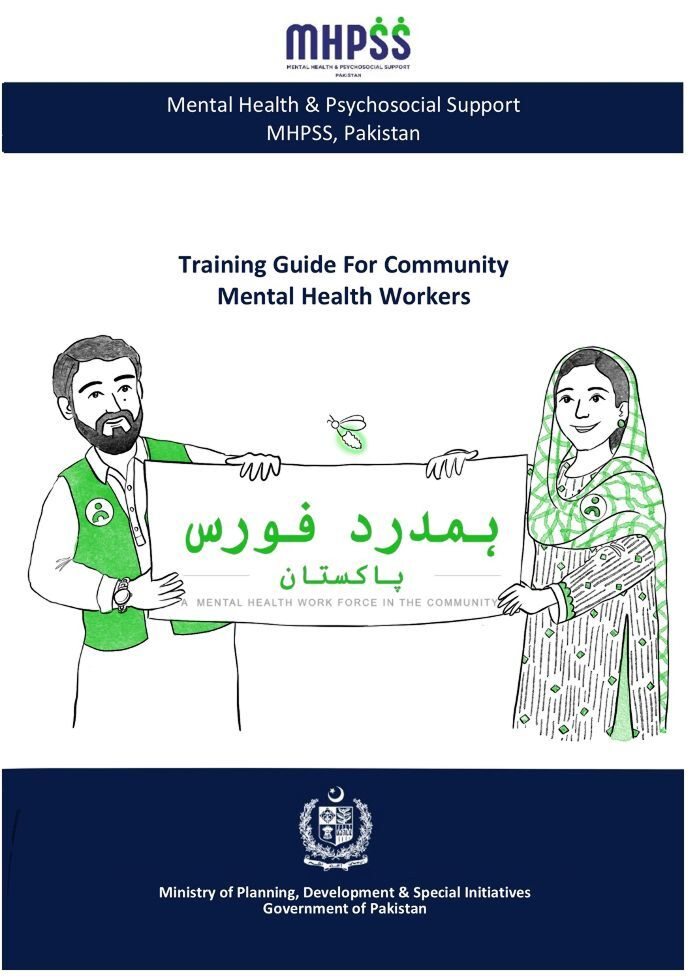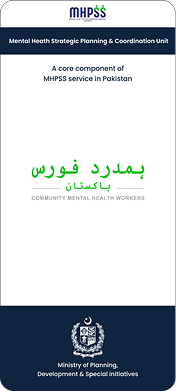Implementation challenges
The challenges for implementing a community intervention in resource constrained settings like Pakistan are summarized in this section [1]
Firstly, given the scale of mental health needs, there is a dire need for a scalable and sustainable intervention at community level [2]. Even if 0.1% of the population of an average district (about one million population) in Pakistan is to be trained as a community mental health workforce, it means training and supervising a thousand people. Secondly, there is no mechanism or system to identify and recruit suitable community workers; to train, supervise and support them; to refer people to accessible services according to their needs; and to collect data and analyze trends for strategically developing mental health services in the community. Thirdly, limited mental health literacy and stigmatizing attitudes towards people with mental health conditions deter people from seeking medical help and instead promote reliance on traditional and faith healers.
Resources for training and supervision
The primary guidelines used for developing the Hamdard Force intervention is the Psychological First Aid guide by World Health Organization [3]. This guide offers a humane, supportive response to a fellow human being who is suffering and may need support. Figure 4.1 here displays the title page of the Hamdard Force guide. The guide has been contextualized to Pakistan’s cultural and healthcare context, using an implementation science framework- ADAPT guidance , a four-stage structure for systematically adapting interventions to new contexts. Triangulation method of data utilizing consensus based, co-production approach involving multi-stakeholders were used in exploration of need and implementation challenges of community-based intervention described above
Next, through the adaptation workshop finalized adaptations were designed across three domains: structural, content and digital and reported using Framework for Reporting Adaptations and Modifications-Enhanced (FRAME) approach [4].
To address gaps in knowledge, knowledge to practice, cultural and healthcare contexts, the content of the guide was modified and simplified, highlighting actionable steps and instructions. Furthermore, the guide was translated into more conversational Urdu for easier comprehension, effective implementation, and its integration into routine healthcare practice, as well as in emergencies.
In view of resource limitation, and growing digital access and penetration in Pakistan [5], digital platform appeared to be the most viable and sustainable solution for a scalable intervention. For this purpose, self-directed online courses in Urdu and English via the Moodle platform have been developed. The Hamdard force guide was structurally adapted into a modular design to enhance clarity, improve organization and navigation. In addition, interactive quizzes, audio visual content and tools for course evaluation have also been incorporated. The course will also collect baseline information about the mental well-being of Hamdard workforce, and the MHPSS offers an intervention to manage stress (described in section 4.2.2).

For settings where online training is not feasible, a printed guide can also be used for conducting face-to-face training.
It is well-established that psychological first aid training without supervision leads to gaps in essential competencies [6]. The challenge to provide supervision was addressed by developing the Hamdard Force mobile application.

The mobile application is a lightweight, low-bandwidth solution for use in resource limited settings, and continues functionality without internet access in an offline mode. The trained workforce can request supervision for both, routine and urgent cases. Figure 4.2 here displays the home screen of the Hamdard force application.
Most of the community-based initiatives lack structured service delivery and referral mechanisms, raising concerns about quality, effectiveness, and ethical service provision.
To optimize and improve pathways to care and treatment outcomes, an efficient referral mechanism is established via the app. It also offers a directory of support services for easy access to essential contacts.
The app can be utilized to refer cases in real time to the MHPSS web-portal; and provide feedback. All the referred cases are received on the MHPSS web portal where cases are assigned accordingly.
Means of verification
For training evaluation, a 20-items knowledge questionnaire has been developed from the PFA Facilitators guide.
A self-reporting 12-items screening tool (General health questionnaire - 12) [7]has been integrated to assess the mental well-being of Hamdard workforce.
References
Humayun et al., 2025 https://doi.org/10.1101/2025.07.17.25331689
World Health Organization, 2015 https://www.emro.who.int/emhj-volume-21-2015/volume-21-issue-9/scaling-up-mental-health-care.html
World Health Organization, 2011 https://iris.who.int/bitstream/handle/10665/44615/9789241548205_eng.pdf?sequence=1
Wiltsey Stirman et al., 2019 https://doi.org/10.1186/s13012-019-0898-y
PTA, 2025 https://www.pta.gov.pk/category/telecom-indicators
Wang et al., 2021 https://doi.org/10.3390/ijerph18094594
Goldberg & Williams, 1988 https://www.scirp.org/reference/ReferencesPapers?ReferenceID=189650
Mental Health Strategic Planning & Coordination Unit Health Section Ministry of Planning, Development & Special Initiatives